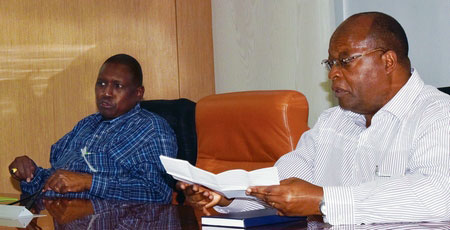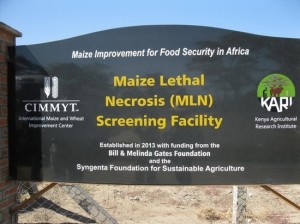All this week, CIMMYT headquarters in Texcoco, Mexico, has the honor of hosting Dr. Eliud Kireger, the Acting Director General of the Kenya Agricultural and Livestock Research Organization (KALRO). Today, we sit with him for a candid conversation on crop research in Africa.
According to Dr. Kireger, one of the burning issues in agriculture today in Eastern and Southern Africa is “low productivity per unit area. The increase we’ve seen in yields across different countries is largely due to expansion in land area.” He attributes this low productivity per unit area to lack of technologies and knowledge that can boost productivity. This dearth translates itself in many ways such as not using fertilizers, improved seed or mechanization.
Another key factor hampering production is climate change, which in Eastern and Southern Africa manifests itself mainly through drought, floods, frost and hail. “There is also an increase in new pests and diseases, as well as postharvest losses, low value addition and lack of regulated markets which erodes the incentive to work hard and produce more. All these are the issues we need to address in our research and development agenda,” Dr Kireger says.
Finance and romance
The crunch in all this is low funding for the agricultural sector. African heads of state committed to devoting a minimum of 10 percent of their national budgets to agriculture in the 2003 Maputo Declaration. Not only have few nations honored this commitment, it is also a disadvantageous relationship, as Dr Kireger reveals. “For example, in Kenya, agriculture accounts for 30 percent of the GDP but the exchequer allocates less than two percent to agriculture, and even less to research. We therefore rely on our partners and collaborators in funding most of our research and development work, and that is where partners like CIMMYT come in to help us bridge the gap by accessing funding we would not otherwise have got, by training our scientists, and by helping us obtain high-quality germplasm.”

But it is a reciprocal relationship between CIMMYT and KALRO, with CIMMYT too enjoying KALRO’s generosity through a rich potpourri of priceless resources – land for field and laboratory work; a robust nationwide network covering all corners of Kenya; immense social capital accumulated through time by a known, tested and trusted name; community mobilization; and local liaison with policy- and decision-makers on sensitive matters such as germplasm exchange and other weighty issues. “In Kenya CIMMYT does not have land, but since we work together, KALRO allows us to use their land for our work,” notes Stephen Mugo, CIMMYT–Africa Regional Representative and also Kenya Country Representative, who has accompanied Dr Kireger to CIMMYT Headquarters. “These are the benefits of synergy: ‘What you do not have, and I have, we share’. There is no single institution — working alone — that can be able to address all the challenges facing agriculture. From very early on, CIMMYT decided that the only way was to team up with national institutions and work together, so that CIMMYT-developed germplasm , know-how and technologies reach intended beneficiaries countrywide for the benefit of maize and wheat farmers. CIMMYT and KALRO jointly design common projects on clear and specific areas to improve maize and wheat, then seek funding for these projects to address drought tolerance, crop pests and emerging diseases.”

One such emerging disease is maize lethal necrosis (MLN), which CIMMYT and KALRO are jointly tackling through ultra-modern shared facilities for MLN screeing and for doubled haploid (DH) technology that both stand on KALRO land. “With these facilities, we are able to screen a large volume of germplasm from both the public and private sectors. DH technology allows breeders to very rapidly— especially for cross-pollinated crops like maize — develop parental lines in about 18 months than can then be used to develop hybrids,” says Mugo. “With conventional methods, the same process could take anywhere between six and eight years. Once we identify maize types that are disease-resistant, drought-tolerant or good for low-nitrogen soils, we can fast-track them for rapid hybrid development. KALRO also facilitates exchange of germplasm — particularly important now in the face of MLN — by liaising with other government agents such as the Kenya Plant Health Inspectorate Service. This helps not only Kenya but also other countries, including both the public and private sector. By working together, institutions are able to solve problems that at first glance seem insurmountable,” Mugo observes.
KALRO and CIMMYT started working on climate-smart crops long before the term was coined. The goal was ‘insurance’ to increase production during drought. CIMMYT embarked on research from the late 1980s to increase production even when drought strikes. Collaboration with KALRO in this work started in the early 1990s, and did not stop there. “We now have a large network of research sites in Eastern and Southern Africa,” says Mugo.
The next frontier, and the future we need not fear if we prepare
Touching on genetically modified crops, Dr. Kireger laments “the negative publicity and misinformation on transgenics. To counter this, one of the first courses of action we are taking is making information available to the general public. Transgenic materials have the potential to resolve some of the problems that we have in Eastern and Southern Africa. We are working together with CIMMYT to provide information to the public because the largest fault-line is lack of information, which opens the door for misinterpretation. This hampers and dents the good work that is being done.”
Mugo concurs: “The only way to address this is for research institutions like KALRO and CIMMYT to provide the correct information, based on authoritative and impartial research findings, for informed public debate on benefits and risks, and how to mitigate risks. For example, research has shown the economic and environmental benefits of transgenic insect-resistant maize which eliminates pesticide use. This shows that transgenics can be deployed to solve problems that conventional means are at present unable to solve. One of these is the need to produce more food for an ever-increasing global population. To achieve this goal, we need to deploy all the technologies at our disposal, including transgenics.”
And switching emphasis from maize and headquarters to wheat and the field, Dr Kireger’s next stop in Mexico this week is Obregon, to get first-hand experience on CIMMYT’s work on this other crop that both institutes work on – not very common in Africa, as most of CIMMYT’s partnerships there focus exclusively on maize. Watch this space for more updates including videos!
And may this fruitful and mutually beneficial collaboration endorsed at the highest levels continue to grow from strength to strength!
Links:
- Photo selection:
- CIMMYT–KALRO MLN workshop for crop scientists, held last week
 Climate adaptation and mitigation
Climate adaptation and mitigation